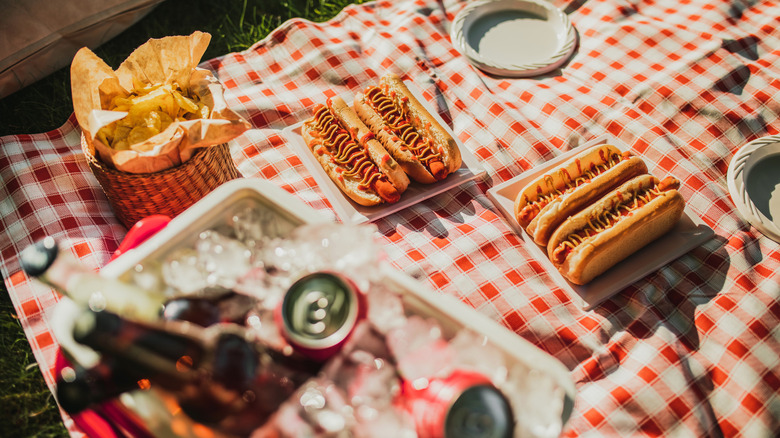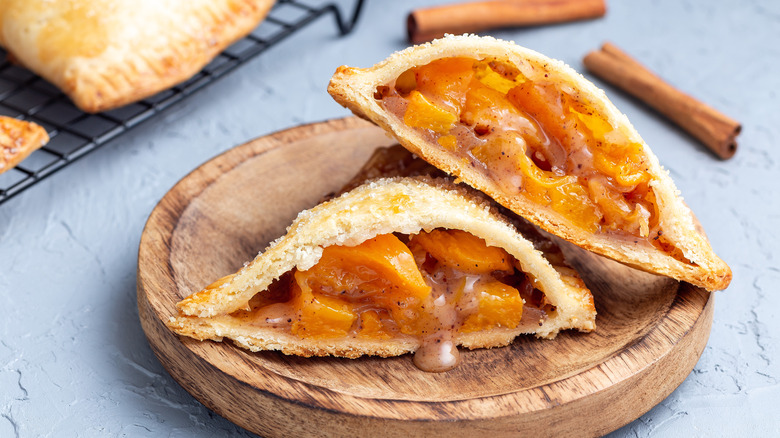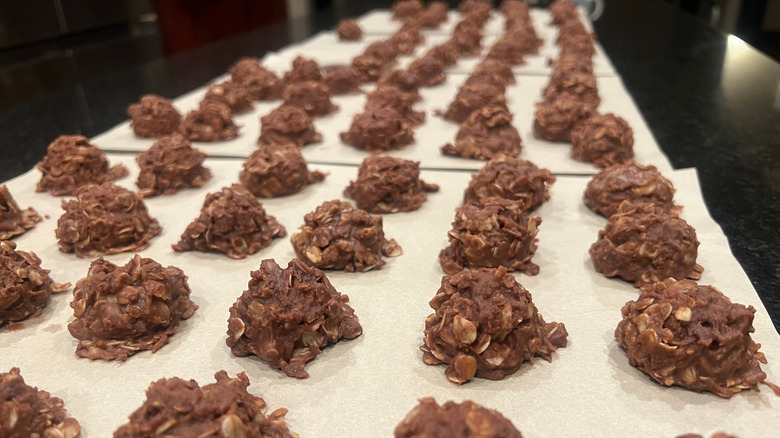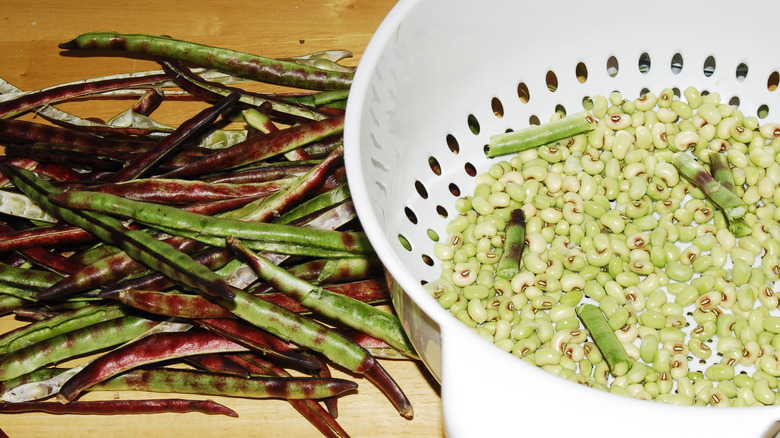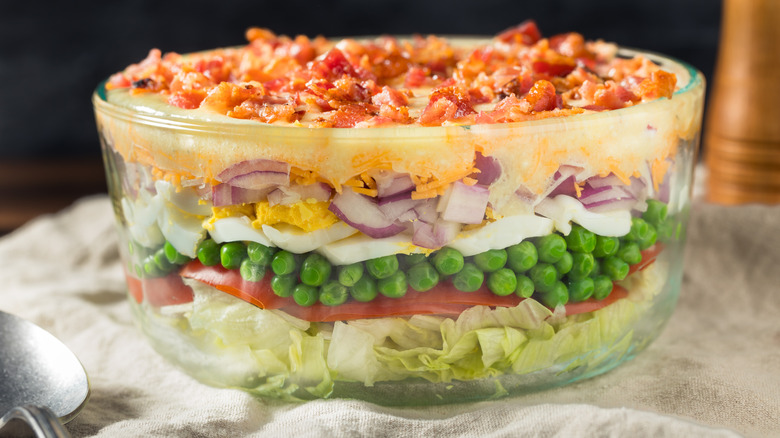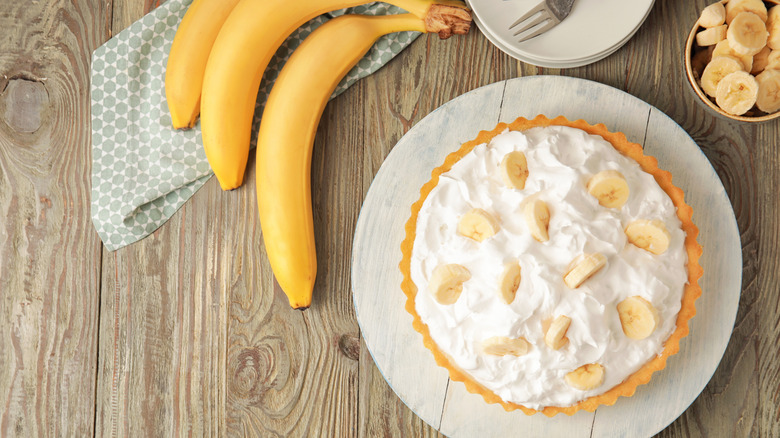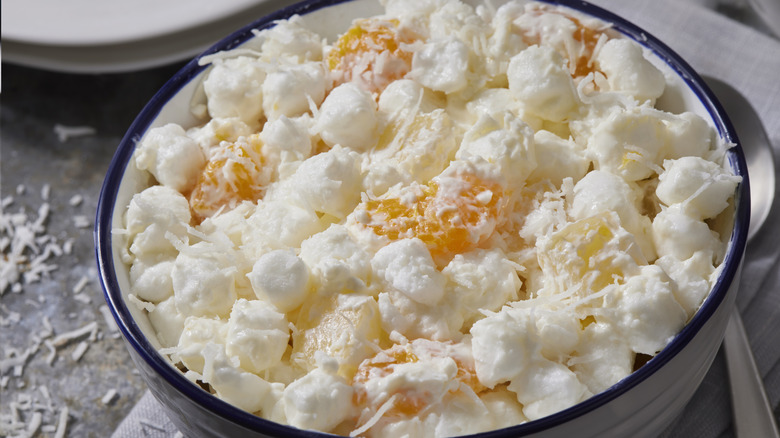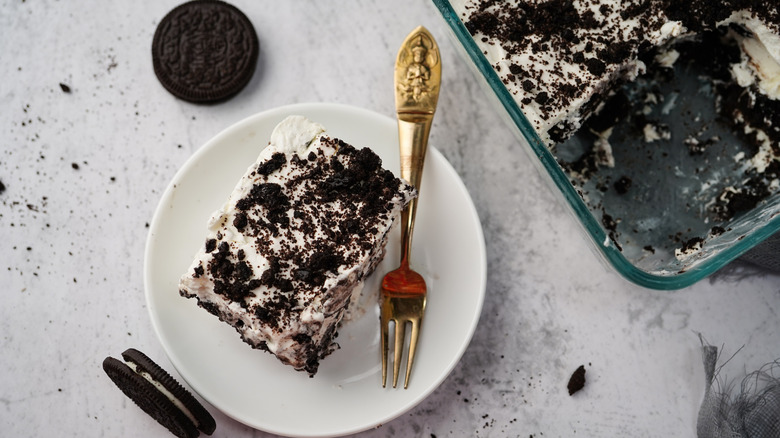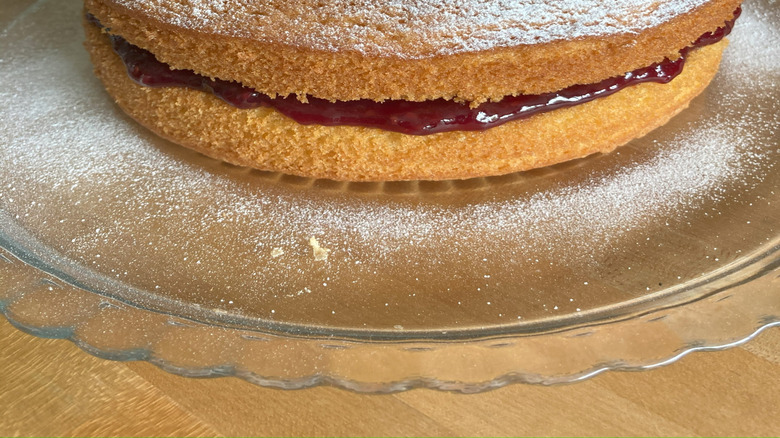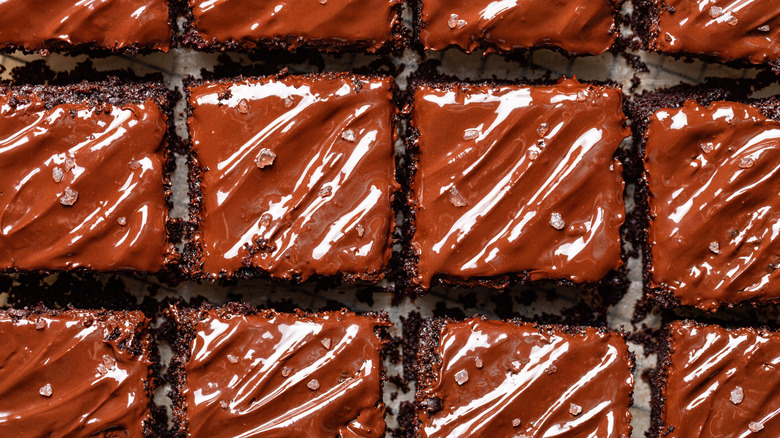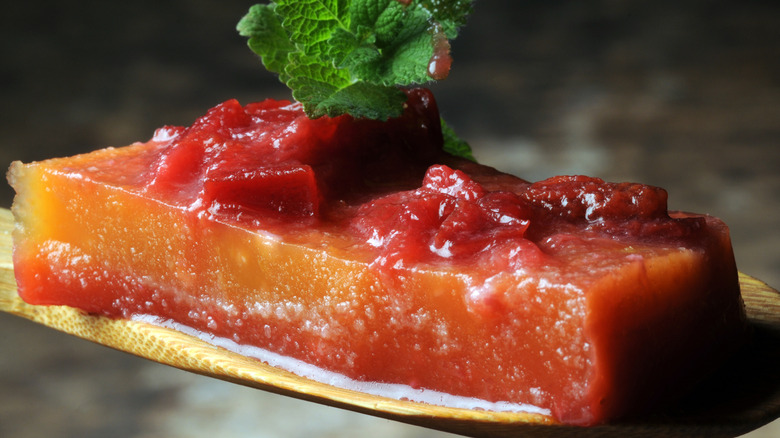Old-School Summer Dishes No One Eats Anymore
Summer is a season full of nostalgia. It evokes memories of long hot days spent in the sunshine, where the only things on your agenda are swimming in the lake, a trip to the ice cream shop and a family cookout. But if you've been eating the same iconic summer foods at your cookouts for a few years now, maybe it's time to go a little further back in the nostalgia machine for some inspiration — or just to look fondly back on the summer dishes of yesteryear.
We broke out some vintage cookbooks to find 11 old-school summer dishes perfect for your summer picnics or backyard barbecues. Some are sweet and some are savory, and all of them are easy to put together. These dishes might have fallen off the most popular list, but you should take another look because these foods are ones you're going to want to put back into your summer rotation.
Creamy Sweet Pea Salad
At one point in time, a version of this creamy sweet pea salad was served at every church potluck and family reunion picnic in the South and Midwest. And exactly what was in this salad depended entirely on whose picnic you were at. There's not a lot of hard data about where the salad was first made, but vintage recipe sites talk about it being a 1950s favorite and it appeared on potluck tables in the 70s as well. It's a dish that deserves another look because it's creamy, crunchy and tastes even better the next day.
The basic ingredients are sweet peas, cheese, and a creamy dressing made from a mixture of mayonnaise and sour cream. The sweet peas can be frozen or fresh (or from a can, though the texture won't be as crisp). You can add in bacon, ham, chopped hard boiled eggs, and red or green onions. A lot of versions add fresh broccoli florets and sunflower seeds. The cheese is either shredded or chopped into little chunks, and you can use cheddar or American (or your favorite blend). Add a little bit of apple cider vinegar for tang and sugar for sweetness if you like. Season with black pepper and salt, but you should also try it with smoked paprika or a little bit of cayenne pepper. There are also versions of this salad that add dried cranberries or water chestnuts. It's a forgiving salad — just don't leave it sitting in the sun for too long.
Peach Fried Pies
Fried pies in the United States are cousins to the savory hand pies found in England, Ireland and Scotland, particularly the Cornish pasty. The pasty was often eaten by miners, farmers and other workers who needed a meal that would keep until mid-day and could be eaten without utensils. When English, Irish, and Scottish immigrants settled across Appalachia and the South, they brought hand pies with them.
Sweet fried pies became popular in the 1800s, especially in places like Arkansas. These half-moon shaped pastries were an easy and fast way to make dessert; a cake might take all day, but a fried pie could be made quickly with inexpensive ingredients most home cooks had on hand all the time. Another plus, they lasted for a long time without refrigeration. With store-bought biscuit dough, fried pies are even easier to make.
You can make a fried pie with almost any kind of filling, but for summer, peach fried pies make an exceptional treat. So why aren't they as popular these days? It's possible people think frying is too much trouble or are concerned about deep fried foods being unhealthy. And while we're not suggesting you have these all the time, but fried pies are worth another look for your summer dining.
No Bake Cookies
No bake desserts are still wildly popular in the summer, but these simple chocolate peanut butter no bake cookies fell out of favor sometime over the last few decades. It's time to bring them back because they are so good and easy to make (perfect for some help from the older kids hanging around your kitchen).
No bake cookies first became popular during the Great Depression, when basic ingredients like eggs and flour were more expensive, but there's not a clear source for these particular chocolate peanut butter no bake cookies. They go by the name no-bakes, cow patties or poodgies. You might also hear them called preacher cookies because, as the story goes, a housewife could look out the window to see the traveling preacher on the horizon and have these cookies ready by the time he reached the door.
Whatever you call them, there really is no easier cookie recipe to make. You need rolled oats, cocoa powder, sugar, salt, milk, peanut butter, vanilla and butter or margarine. You boil everything but the peanut butter, vanilla and oats — those get stirred in after you take the pan off the heat — then drop the mixture onto parchment paper and let them cool to set. A tip for making the perfect cookie is to think of the boiling mixture like candy and cook it to the soft ball stage (235˚F) on a candy thermometer.
Purple Hull Peas
There's nothing that says summer more than fresh field peas, especially if you grew up in certain parts of the country where summer days are for picking peas out of the garden and sitting on the front porch shelling them. If you ever walked away from those shelling sessions with purple fingers, you know the joys of fresh purple hull peas. If you don't, you need to head to the farmers market right now. Purple hull peas aren't as common on the summer table these days and that's something that should change.
Most people are familiar with black eyed peas, even if they only eat them in Hoppin' John on New Year's Day. Purple hull peas are a cousin to black eyed peas, with a milder taste and a creamier texture. You might see them called cow peas (because they were often grown to feed cows) or pink eyed peas because of the ring of pink around the eye. They're available mostly from farmers markets and local farm stores from late spring through early fall, and if you want some later in the year, it's best to buy and freeze them yourself because it's rare to find them out of season.
You can use purple hull peas in any recipe where you would black eyed peas. A good summertime meal is purple hull peas cooked with a little bit of bacon and served next to cornbread. But you can also use them in a Texas caviar recipe or instead of the traditional chickpeas in hummus.
Seven Layer Salad
A seven layer salad is exactly what it says on the label: seven layers that start with chopped iceberg lettuce on the bottom, sliced fresh tomatoes, green peas, sliced hard boiled eggs, chopped red onions, shredded cheddar cheese, and topped with a tangy mayonnaise dressing and crispy bacon. It's meant to be served in a large glass bowl so that everybody can see the layers and then mixed together on the plate as its dished out.
Why did seven layer salad stop being so popular? Because it's a mid-century salad recipe, it might seem a little old fashioned today. It's probably still made by your grandparents or great grandparents, but listen — it's a good salad. It's fun to make and looks like it took a lot of skill to make even though you'll know that it's the easiest thing. Seven layer salad is great for a summer potluck; it stays crispy and fresh, it's filling, and it uses some of summer's best produce. You can also customize it, swapping in avocados, green onions, celery, or chickpeas.
No Bake Banana Breeze Pie
A lot of popular recipes in the 20th century were created by food manufacturers who wanted to sell their products. No bake banana breeze pie falls into that category (but that doesn't make it any less delicious). The August 1975 issue of "Ladies' Home Journal" published a recipe featuring Eagle Brand sweetened condensed milk, Dole bananas and Kellogg's Corn Flakes. The name likely comes from the idea that making this pie is a breeze; the ad reads "Banana Breeze. The shortcut cream pie."
Most no bake pies use a graham cracker or cookie crust; banana breeze pie uses corn flakes instead, which makes for a uniquely buttery and crunchy pie crust. Like a regular banana pie, sliced bananas are spread over the crust and then topped with a no bake cream cheese, lemon juice, and whipped topping filling. Chill the pie and then slice the remaining bananas over the top of the pie.
Pineapple Fluff
Using marshmallows in salad was all the rage in the 1920s. There was a new manufacturing process that allowed easier and faster production of marshmallows and so food manufacturers began promoting their use in all sorts of recipes. Cooks even started adding marshmallows to ambrosia, the beloved salad made from oranges and coconut. In the '70s, home cooks created different versions using new ingredients like instant pudding, which was introduced by Kraft Foods in 1975. One of the most popular twists on ambrosia was watergate salad, a concoction of pistachio pudding, crushed pineapple, mini marshmallows, and Cool Whip topping. Although it's not clear how it got its name, it was first published as a recipe in The Washington Post in 1975. But it was also known by another name: "green fluff" because of the green pistachio pudding mix.
Switch up the pistachio pudding for vanilla pudding and add coconut, and you get pineapple fluff. Like ambrosia and watergate salad, this no bake dessert used to be a favorite potluck dish, but for some reason fell out of fashion. That should change, though, because pineapple fluff is easy to make and fun to eat. All it takes is six ingredients: crushed pineapple (with the juice), instant vanilla pudding, shredded coconut, Cool Whip, chopped pecans, and mini marshmallows. Mix and chill, then serve to rounds of picnic applause. You can also give it a bit of a piña colada spin by adding a splash of rum extract or coconut rum.
Icebox Cake
Icebox cakes aren't technically cakes. This distinctly American dessert featuring layers of cookies and whipped cream is closer to a British trifle recipe or the retro dessert Charlotte Russe, and not something that would exist without the modern miracle of refrigeration. Iceboxes were first made in the early 1800s and were literally boxes with a compartment for ice that kept the food stored inside the box cool. The first electric icebox for home use was invented in 1913, though it wasn't until the late 1920s and early 1930s that the refrigerator started to become a common home appliance. Seeing an opportunity to increase sales, food manufacturers started creating and promoting recipes that used this fancy new technology.
In 1929, Nabisco started selling its Famous Chocolate Wafers with a recipe for icebox cake printed on the side of the box and in cookbooks printed by the company. It was convenient, delicious, and allowed home cooks to show off the fact that they owned a refrigerator. Today, the icebox cake deserves a spot on your summer meal rotation because it's easy to make and doesn't require you to heat up your kitchen, plus it's just that good. All you need are chocolate cookies and sweetened whipped cream (homemade or store bought, your choice). Layer the cookies with the whipped cream — your number of layers and cream will depend on what shape dish you use — then cover and refrigerate for at least six hours. The time in the fridge causes the cookies to soften so that their texture is more like cake. Serve with more whipped cream and bask in the easiest summer dessert.
Washington Pie
Washington pie is actually a cake. The recipe first appeared in "Mrs. Putnam's Receipt Book and Young Housekeeper," a cookbook published in 1850 by Elizabeth H. Putnam and was most likely named after the first U.S. president, George Washington. The confusing name comes from the fact that layer cakes in the 1800s were often baked in pie tins. According to Atlas Obscura, Washington pies were so popular during the mid 19th century that any shallow round baking tin was often called a "Washington pie plate." You don't see Washington pies too much anymore, though you might see its relative, the Boston cream pie. While the chocolate-covered Boston cream pie might be more popular today, the Washington pie deserves another look for its ability to sit outside in the heat.
A Washington pie is two layer cakes with raspberry jam sandwiched between the layers and dusted with confectioner's sugar. This not-too-sweet cake is ideal for a mid-morning snack and is best made the night before so the jam has to soak into the cake layers. Because it doesn't have a butter or cream-base icing (though you can top it with whipped cream), this cake is perfect for picnic baskets and summer potlucks.
Cherry Cola Cake
Believe it or not, Coca-Cola is a common ingredient in Southern cake recipes. It's not clear exactly when Southerners started adding Coke to their cake batter, but the first published version appeared in the The Charleston (West Virginia) Gazette in 1952, where it placed third in the paper's weekly contest (and second place in the "unusual" category). There's baking science behind the unusual ingredient — the carbonation adds a lightness to the batter, making the baked cake extra fluffy, and the added sweetness amplifies the chocolate flavor.
While you might still see cakes that use cola in them gracing buffet tables today, there's a version of this old-fashioned cake that doesn't get much love anymore. Cherry Cola Cake is a twist on the classic that deserves to be a summer favorite again because there's nothing better than the chocolate cherry flavor combination. It's also an easy cake to make — you're simply replacing the standard Coca-Cola used for a Coca-cola cake recipe with Cherry Coke. If you want to amp up the cherry flavor even more, you can add a can of cherry pie filling, too. This cake works as a sheet cake or in a bundt pan, and don't forget to add a little Cherry Coke to the frosting or glaze!
Tomato Aspic
Why don't people cook with aspic anymore? This meat-based gelatin used to be the basis for some interesting (and, yes, weird) food combinations, but it was useful as a way to preserve food and use up scraps in a creative and visually pleasing way. But aspic got a bad reputation as something served at stuffy dinner parties by your grandparents and it fell out of favor. You won't see aspic on many picnic tables in the summer, and we think that needs to change.
One great way to create a summer-friendly aspic dish is tomato aspic. It's bright red, showcases the bounty of summer-ripe tomatoes and is the perfect accompaniment to other warm weather dishes. You can think of tomato aspic as being a cold version of tomato soup (or a sliceable Bloody Mary). Combine unflavored gelatin and tomato juice, and then add your choice of seasoning and spices. You can also add other vegetables, fruits, or even meat to the gelatin. Chill the aspic in a pretty mold and serve with cheese straws, deviled eggs or grilled shrimp. Or if you have a mold with a well in the center, serve the aspic with tuna or chicken salad to go full-on retro. If you don't have a fancy mold for your tomato aspic, you can use a Bundt pan, a ramekin, or even a mixing bowl to give your aspic a fun shape.
